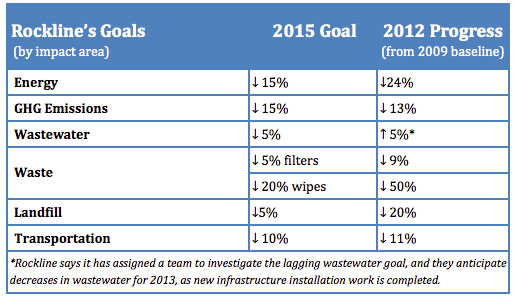 |
| Reviews and Templates for Expression We |
Unlocking sustainability's hidden value

Why do sustainability achievements come naturally for some companies, while others struggle to achieve even modest targets for impact reduction? I wish I could say the difference is some companies hire our sustainability consulting services and others don’t. But the truth is, despite abundant guidance and support, I’ve seen some clients take only faltering steps, while others take the ball and run. So when a company clearly has winning ways, it makes sense to take a closer look.
There’s a good chance you’ve used Rockline Industries’ products without ever knowing it. The family-owned, private-label manufacturer produces everyday items like baking cups, wet wipes and coffee filters for big names including Walmart, Seventh Generation and Starbucks. In 2008, we helped Rockline launch a sustainability program to respond to increasing demand from their customers for sustainability data and commitments.
A few weeks ago, Rockline published its most recent sustainability report, which shows it has blown past all but two of its 2015 targets. Ongoing initiatives are now so well integrated with operations that the company’s sustainability coordinator is actually reducing the number of hours he spends on program activities.

What’s Rockline’s secret? It is an exceptionally well-managed, organized and disciplined company. As a result, it has had no difficulties following the sustainability roadmap we created together. Setting targets, establishing accountability, budgeting for solutions and tracking progress was nothing new for them. The process, tools and information we presented were an easy fit and have allowed company management to prioritize sustainability throughout the company, from product design to plant operations to communications and marketing.
Mastering the fundamentals of analytics
For example, as a successful manufacturing company with more than 2,000 employees, Rockline mastered the fundamentals of analytics long ago. The dashboard metrics we provided were just another tool for measuring and reviewing a results-oriented program. Rockline’s manufacturing sites process different materials, but waste metrics give a comparative benchmark against each site’s baseline and improvements at other sites.
This kind of comparison is a great motivator, and a solid waste team at the Sheboygan, Wisc., facility found a company 15 miles up the road that makes plastic toilet seats and is willing to pay for the use of Rockline’s empty plastic containers as raw material. Naturally, Rockline also tracks the financial savings the sustainability program has achieved, but it doesn’t disclose the figures. Suffice it to say, Rockline President Randy Rudolph describes the program as having a “very positive financial impact” on the bottom line.
Even more than organizational competence, the thing that stands out with Rockline is its all-in commitment. It’s not enough to have a well-designed sustainability program and the necessary tools and information to carry it out, because the biggest challenge is sticking to the program over time. I’ve seen companies distracted from the task in a dozen different ways, while Rockline’s full executive team – the President, VPs, Senior VPs, Director of Global Engineering and the heads of manufacturing, sourcing and sales — were at the table not only at the start of the consulting process, but throughout the sustainability journey. Rockline has created full executive alignment for energy, GHG emissions, waste and transportation goals, and integrating them into their management system. Within departments and facilities, they assigned Green Leads responsible for implementing and tracking specific initiatives and meeting monthly with their counterparts.
Spreading accountability in this manner created company-wide ownership of the program and empowered departments to draw on their own resources and expertise. For instance, when a factory audit revealed opportunities for better leak detection, repair and sizing of compressed air systems. Rockline’s manufacturing and engineering group promptly spread those learnings throughout the company’s six global facilities.
What exactly goes into creating a sustainability program for a company like Rockline? The top strategies that we have deployed and co-created since 2009 are:
- Establishment of a sustainability vision, goals and management system
- Facility audits for energy, water and waste
- Product and packaging life cycle assessments
- Creation of a Dashboard system for metrics
- Guidance on product development, manufacturing, logistics & marketing
- Product-greening scorecards
Josh Eldridge, the company’s Global Environmental Sustainability Coordinator confirms that success is all about consistency. “Instead of rushing to take care of whatever issue makes the most noise, our across-the-board commitment keeps the sustainability program going and focused on our 2015 goals,” he said.
Eldridge’s statement squares with my own observation over the years: Given the target, tools and know-how, strong companies that are accustomed to making regular improvements on quality, innovation and/or manufacturing will naturally excel at sustainability, because they understand the importance of executive alignment, measurement and accountability. However, it’s also true that learning to execute on sustainability can have a reverse effect of sorts, teaching less-experienced organizations the value of these elements.
In that regard, sustainability programs are great practice for other cross-cutting, enterprise-wide initiatives, whether that’s new product introduction, business expansion, or implementing an enterprise IT system. Ultimately, sustainability programs done right can have profound spill-over effects in business. Perhaps this is the greatest untold value of our collective work.
|
|
|
|
Copyright 2011 Energy and Technical Services Ltd. All Rights Reserved. Energyts.com |